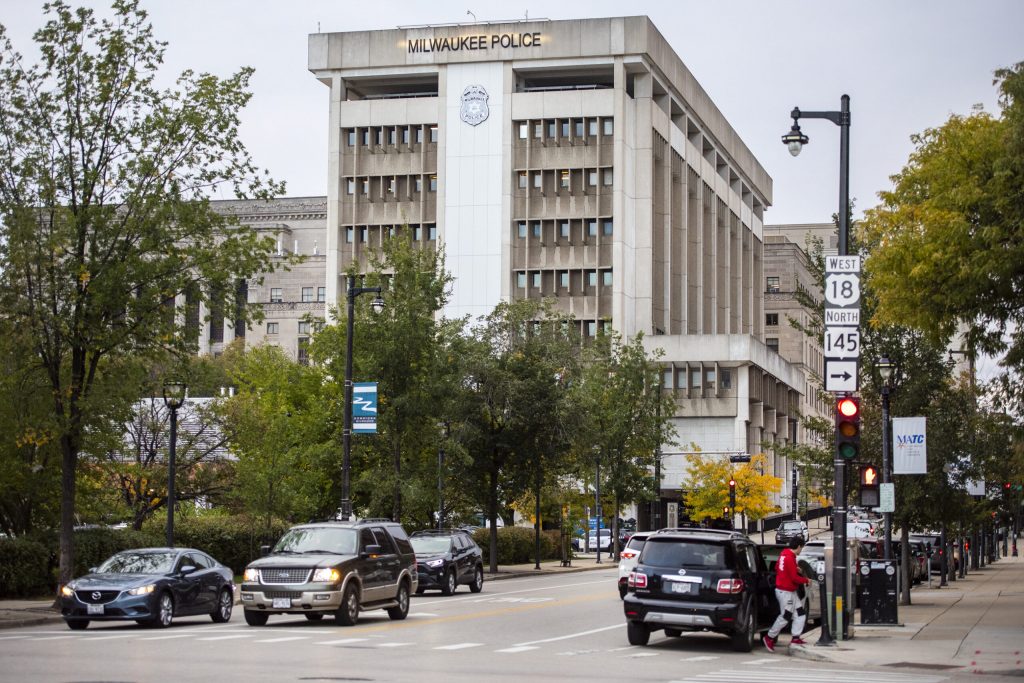For Two Straight Years, Milwaukee’s Homicide Rate Has Fallen
A close look at the work violence prevention and interruption plays in attempting to continue that trend.
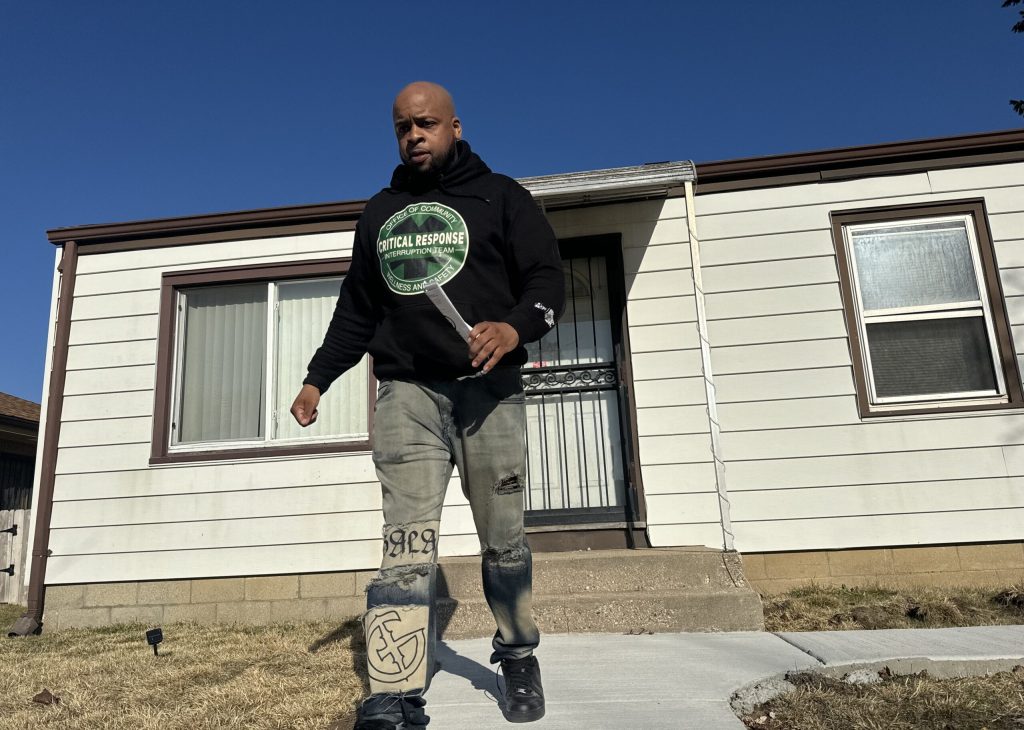
Stephen Hopkins with Milwaukee’s Critical Response Team hands out brochures following a recent shooting on the city’s north side. Evan Casey/WPR
Jose Malave had been in and out of jail and street gangs for years.
Now the Milwaukee native and former gang member is on the front lines of the city’s effort to get a grasp on violent crime.
“I’m tired of seeing all the youth killing each other every day, going in and out of jail,” Malave said. “I wanted to make an impact on my community.”
On a sunny Friday afternoon in March, he and Stephen Hopkins, the director of the city’s Critical Response Team, went from door to door near the site of a recent shooting on the city’s north side. Three weeks earlier, two people were killed in a shooting at Dineen Park, just a half mile away.
“Every time there’s a shooting in the area, we come down and check on the residents,” Hopkins told a man they met walking by them on the street.
He handed the man a brochure with resources for victims of violence.
“We want to make sure that the residents over here feel safe,” Hopkins said in an interview. “You know, reach for them, in a sense, because it’s kind of like a forgotten pocket [of the city].”
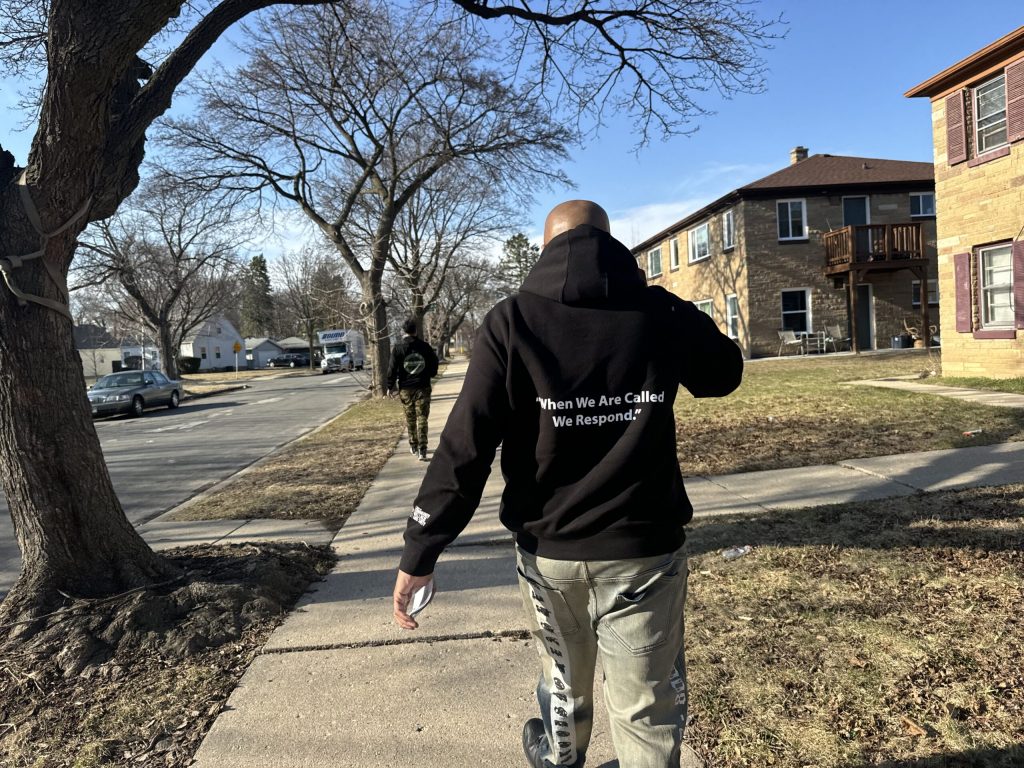
Stephen Hopkins and Jose Malave (left) with Milwaukee’s Critical Response Team hand out brochures in Milwaukee following a recent shooting nearby. Evan Casey/WPR
The door-to-door outreach is one way the team is working to lower the rate of gun violence in a city that’s been plagued by the problem for decades.
Just over two years ago, community leaders gathered to call for peace after homicides claimed the lives of 214 people in Milwaukee in 2022 — the highest number ever recorded in the city, and the third year in a row that the city had broken its homicide record.
But that trend reversed. Homicides declined in 2023 and 2024, and as of mid-April there have been fewer this year than there were at this time last year. Nonfatal shootings are also down 22 percent this year compared to last year, according to crime statistics from the Milwaukee Police Department.
David Muhammad, deputy director of the Milwaukee County Department of Health and Human Services, said that is worth celebrating.
Some community leaders have pointed to violence prevention initiatives including the Critical Response Team as one factor behind the decline. Members of the Milwaukee Violence Response Public Health and Safety Team, a collaboration among several community groups and organizations focused on preventing violence, meet often to discuss what’s working and what isn’t.
A team meeting in March came weeks before warmer weather hit the city, when violence often spikes. It also came as the decline in homicides in the city might have stalled. As of April 16, there had been 26 homicides in Milwaukee. Last year at that same time, there had been 28.
To Muhammad, violence prevention work can include a wide range of things, from street outreach to youth programming to peer support for victims of violence.
Ultimately, the goal is to address root causes.
“Violence prevention is the act of reaching people where they are — without judgment or without deepening involvement in the criminal legal system — and getting their needs met and helping them work through their own thought process to see that there’s a better way to navigate life’s challenges,” Muhammad said.

Members of the Milwaukee Violence Response Public Health and Safety Team meet during a meeting in March at Turner Hall in downtown Milwaukee. Evan Casey/WPR
Shootings and homicides decline, but city officials want sustained improvements
There were 132 homicides in 2024, down from 172 in 2023, according to crime data from the Milwaukee Police Department. The 2024 figure was a 23 percent decline from 2023 and a 38 percent decline from two years prior.
“We are headed in the right direction. That’s good news,” Milwaukee Mayor Cavalier Johnson said. “But we all have to be vigilant — not just the police, not just me as mayor, but everybody in the community has to be vigilant.”
Data from the Milwaukee Violence Response Public Health and Safety Team found in 2024 compared to 2023:
- There were 39 fewer youth homicide and youth nonfatal shooting victims.
- There were 93 fewer people ages 18 to 24 who were the victim of a homicide or nonfatal shooting.
- There was also a 30 percent decrease in the number of victims aged 24 years old and younger involved in nonfatal shootings in the city.
But even with these declines, homicides still have not returned to pre-COVID-19 pandemic levels in the city. There were 97 homicides in Milwaukee in 2019, according to data from the Wisconsin Department of Justice.
Tracey Dent, a community activist with the Peace for Change Alliance, said gun violence is still something many residents on Milwaukee’s north side have to deal with every day.
“But if you would ask someone that’s living on the north side … they will say, well, I hear gunshots every night,” Dent said. “So I don’t know if [shootings are] actually going down. … That’s why it’s important for us to make sure that we all continue to work together.”

Milwaukee Police Chief Jeffrey Norman speaks at a press conference in Milwaukee on Tuesday, July 16, 2024. Evan Casey/WPR
Milwaukee Police Assistant Chief Nicole Waldner also said the numbers are encouraging, but she wants to see a sustained decline.
“I’d like to see something happen more than just two years,” Waldner said. “I would like to see this continue for five years.”
‘That neighborhood is still traumatized’
Two leaders at the helm of the Milwaukee Office of Community Wellness and Safety have both been affected by violence in their own lives.
But he took another path, attending college to be an engineer.
“I went back to my neighborhood to try to change the way those guys were living, trying to give them an opportunity to make it out,” Hall said.
In 2011, Karin Tyler’s son was killed during a home invasion.
Shortly after that, her father died in a hit-and-run crash in the city.
“If we can make a difference in another family’s life, that’s just amazing to me,” Tyler said. “To just make sure other people don’t have to live with these same situations and the pain is why I do this.”
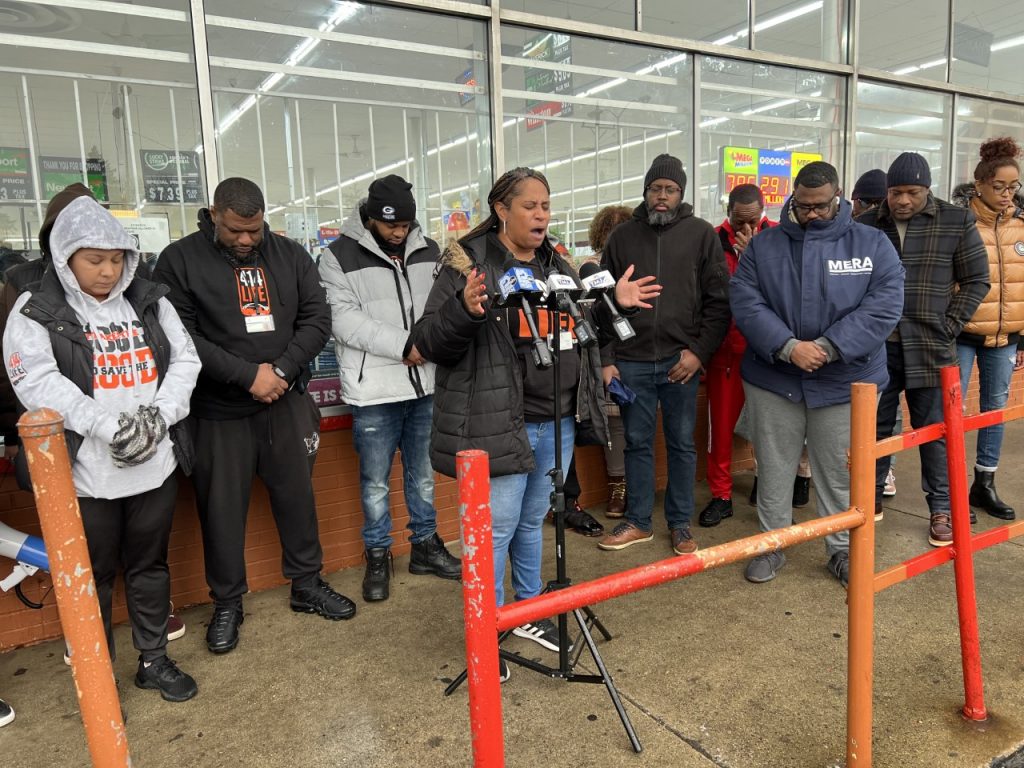
Community organizers in Milwaukee pray for peace following a violent 2022 on Jan. 3, 2023. Evan Casey/WPR
The Office of Community Wellness and Safety, formerly the Office of Violence Prevention, has several initiatives focused on addressing the root cause of violence in the city.
“We ideally want to stay ahead of violence, meaning get to primary prevention,” Tyler said.
But far too often, teams with the office have to respond to shootings and homicides. Even in cases where police make an arrest following a shooting, more work needs to be done to heal the community, Hall said.
“That neighborhood is still traumatized,” Hall said. “There’s kids that have seen this shooting. There’s people that heard the shots from a block away. There’s people that are scared now.”
414Life focuses on educating the community about the harms of gun violence. Hall said staff with that team usually responds to regular shootings among neighbors, students and other youth.
“They actually go in and make connections within the community,” Hall said.
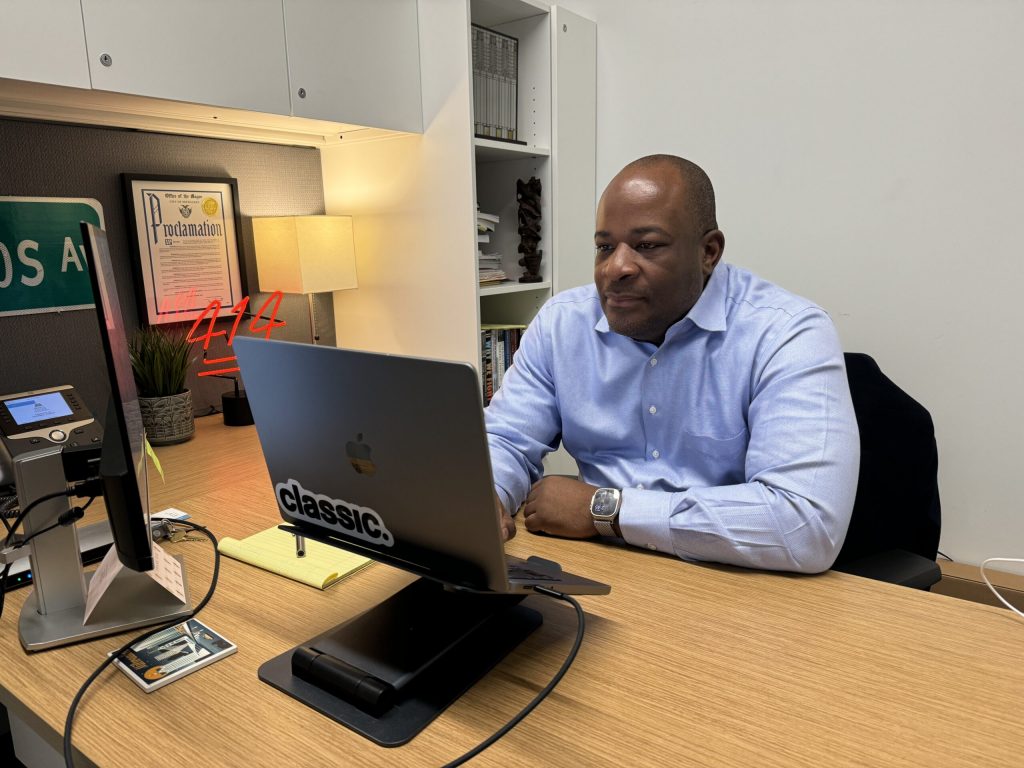
Reggie Moore is the director of Violence Prevention Policy and Engagement at the Medical College of Wisconsin. Evan Casey/WPR
Reggie Moore has been involved in community organizing work in Milwaukee for decades. As the former director of the city’s Office of Community Wellness and Safety, in 2017 he helped create the Blueprint for Peace, an investigation into preventive measures and strategies for the city to follow when it comes to addressing violence.
Moore, who is now the director of Violence Prevention Policy and Engagement at the Medical College of Wisconsin, works with 414Life.
Last year, that team identified the Old North Milwaukee neighborhood as a “priority neighborhood.” Moore said homicides were down 23 percent in that neighborhood from 2024 compared to 2023.
“The outreach team canvases daily in Old North Milwaukee, not just building relationships with business owners and … residents, but also the young people hanging out on the corner, or the adults hanging out on the corner, or individuals, again, who are known to be involved in things that could lead to violence in their lives,” Moore said.
Violence interruption efforts, programs for youth are part of city’s work
The Critical Response Team also works closely with organized street gangs in the city to prevent shootings. Members of the team responded to over 300 incidents last year, according to data from the office.
One of the bigger efforts is preventing retaliatory shootings.
“There may be a homicide, and then we’re trying to get ahead to make sure people don’t retaliate against that person, and then the violence continues,” Tyler said.
Hall said a retaliatory shooting usually takes place within 48 hours. That’s usually around when the victims of a homicide hold a vigil.
“It’s become kind of the norm to attack the vigil after a person is murdered, so we have to get in there immediately after a shooting,” Hall said.
Hopkins and others with the team help mediate conflicts between street gangs.
“Usually, there is a chain of retaliation shootings after one of these bigger, older street gangs have conflicts,” Hall said.
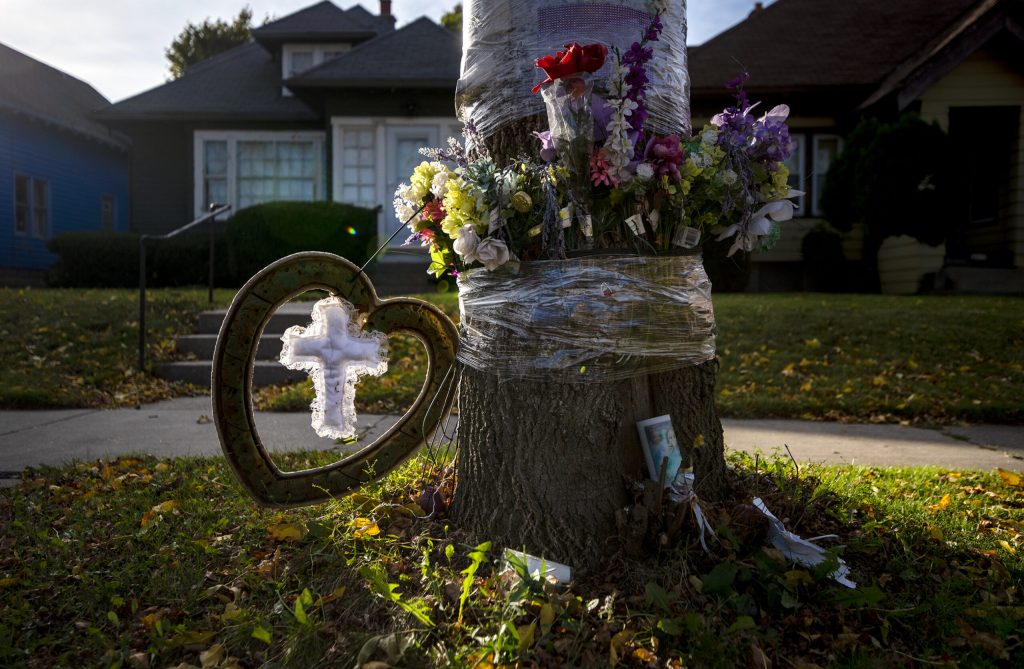
A memorial for Bianca Bates, a 31-year-old woman who was fatally shot, is displayed Tuesday, Oct. 26, 2021, in Sherman Park in Milwaukee, Wis. Angela Major/WPR
Some of the work includes awareness campaigns, but citywide efforts to get youth off the streets during the summer months have also increased in recent years.
- The Safer City MKE initiative, where children go on camping trips, go on tours of the city, take art classes and participate in a mental health boot camp, started in 2023.
- Camp RISE is aimed at Milwaukee kids ages 10 to 15. The summer program “introduces them to opportunities, life skills and civic engagement,” according to the city.
- The city’s second Milwaukee Peace Week was held last year. It’s aimed at fostering “dialogue, understanding and collaboration among residents of all backgrounds,” according to a statement.
- The city also has a recreation program aimed at keeping children off the streets from 5:30 to 9 p.m. five days a week during the summer.
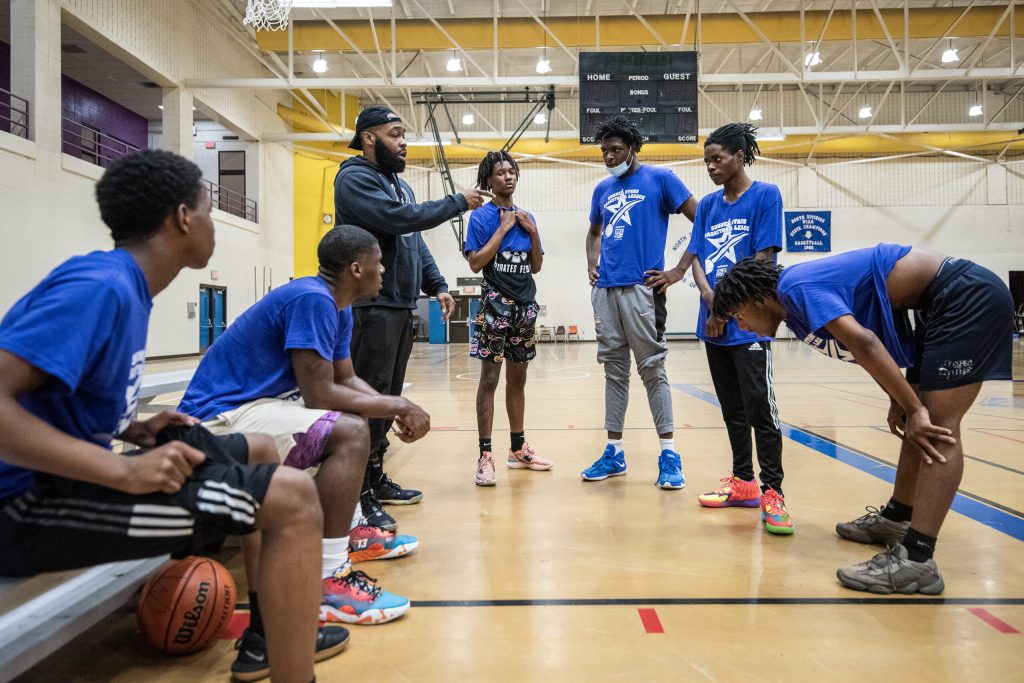
A basketball game is played as a part of a Twilight Center on Wednesday, July 12, 2023, at North Division High School in Milwaukee, Wis. Angela Major/WPR
Milwaukee County also partnered last year with the national nonprofit Advance Peace, which focuses on young people involved in gun violence through a fellowship program that lasts 18 to 24 months. The program’s fellows are matched with mentors who help connect them to resources.
A report from the Center for Global Healthy Cities at the University of California, Berkeley, researched the program’s effectiveness in Lansing, Michigan, from October 2022 through March 2024. The report found the team of outreach workers and mentors there “prevented 41 potential shootings by mediating conflicts where guns were present.”
There are nine fellows enrolled in the program in Milwaukee.
“Those life skill classes touch on everything from conflict resolution to healthy relationships, job readiness,” said Fabiana Guzmán, the strategy manager of Advance Peace in Milwaukee.
Despite progress, Milwaukee still faces obstacles to addressing violence
Once a week, all of the district captains of the Milwaukee Police Department meet at the department’s administration building to discuss the city’s most violent cases.
Shootings. Carjackings. Homicides.
Representatives from the Office of Community Wellness and Safety attend those meetings as well.
“We’re working not only to put information out there to identify people and help us in cases where we’ve kind of stalled out, we’re also working with the families and the victims of crime so they don’t feel left alone and they don’t become victims again,” Waldner said.
Waldner still believes that far too many people have easy access to firearms in the city.
“In certain instances amongst these groups where we have high crime areas and people involved in this lifestyle — it’s shoot or be shot,” Waldner said. “And I need that to change to start feeling better about the direction our community is going.”
Johnson has often called on state and federal lawmakers to pass stricter gun laws. The Giffords Law Center to Prevent Gun Violence ranked Wisconsin as a C for its “gun law strength.”
But city officials can’t control gun laws, which are set by state or federal officials. That makes local efforts crucial.
Ernesto Lopez, a senior research specialist with the Council on Criminal Justice, said violence prevention works, but it’s also important for the city to track its data.
“What’s important … is whenever a city implements these programs, that they also devote resources to evaluating the effectiveness of these programs,” Lopez said.
Moore also said he believes violence prevention work is making a difference.
“I think it’s really about sustainability … and staying the course of things that work,” Moore said.
Homicides in Milwaukee went down 2 years in a row. Can the city build on that success? was originally published by Wisconsin Public Radio.
If you think stories like this are important, become a member of Urban Milwaukee and help support real, independent journalism. Plus you get some cool added benefits.
Political Contributions Tracker
Displaying political contributions between people mentioned in this story. Learn more.


